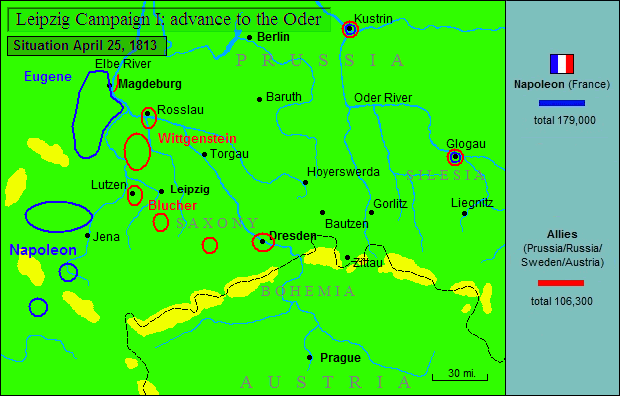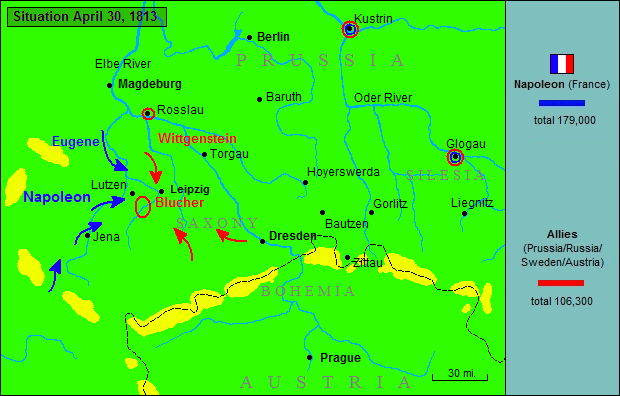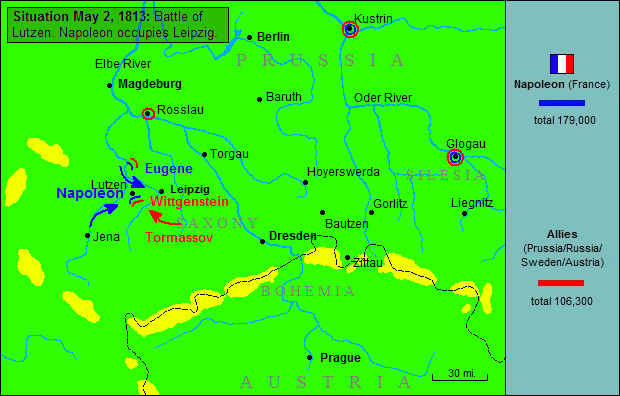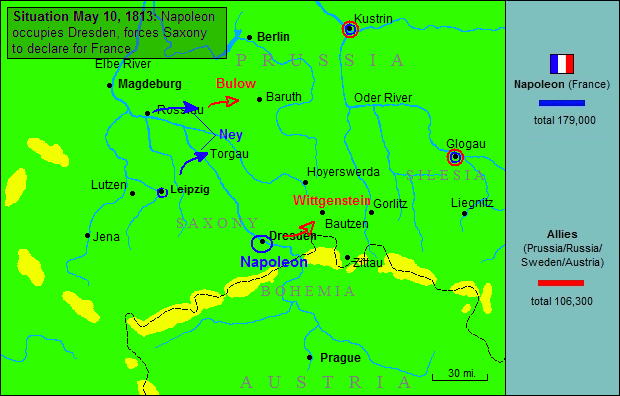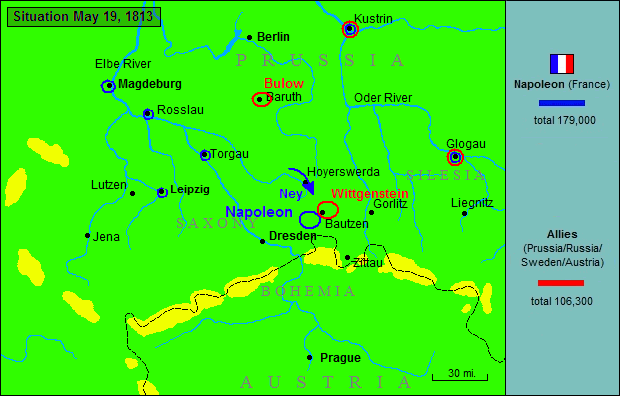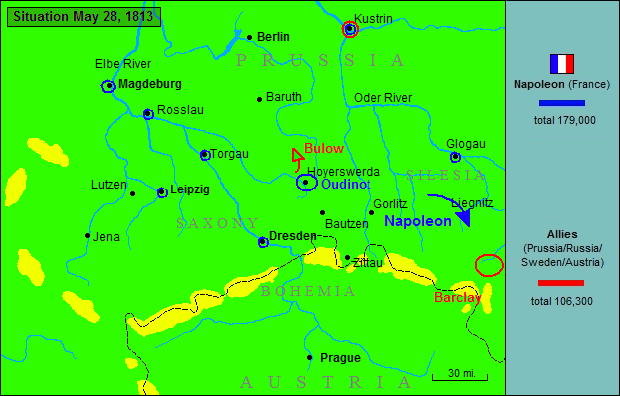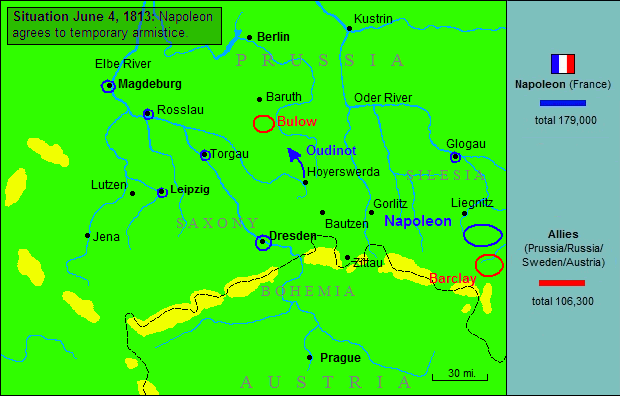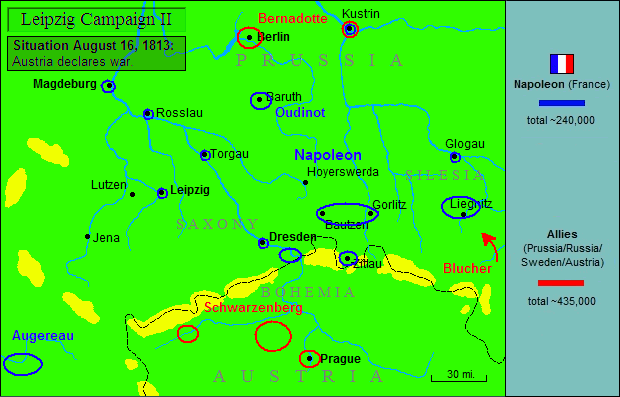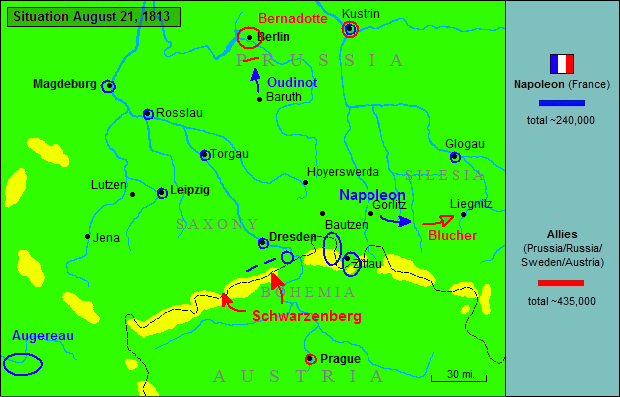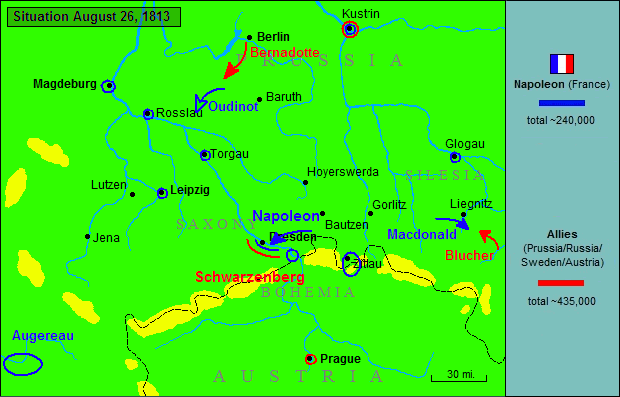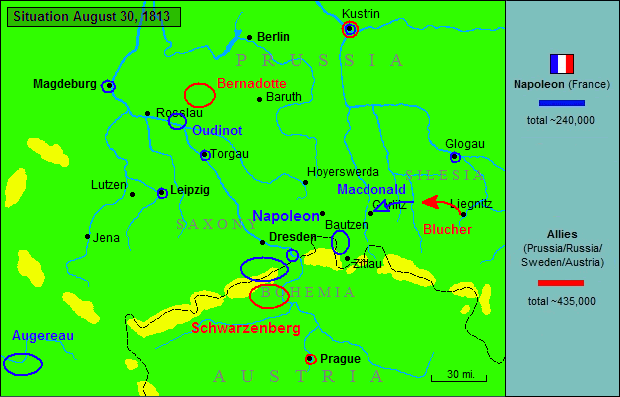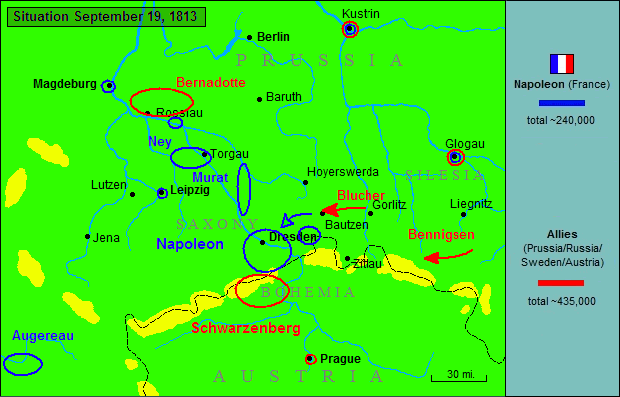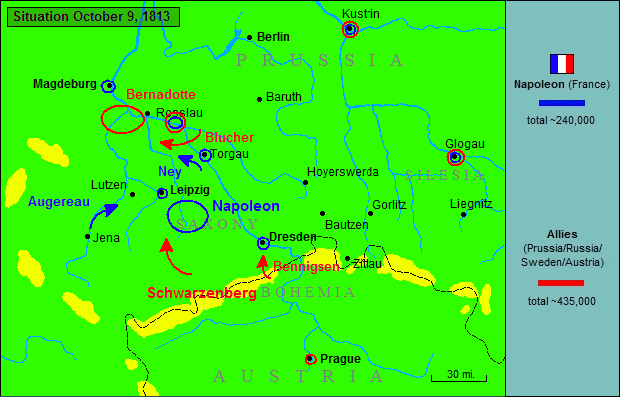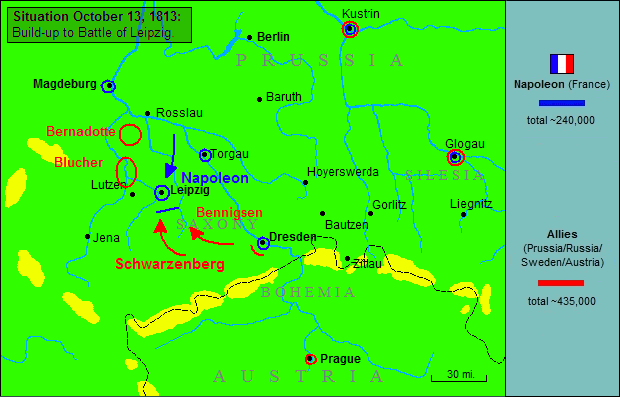
In view of Napoleon’s treatment of Prussia following the Battle of Jena, the actions of the Prussian monarch were to be expected. Having suffered the loss of much of his territory, not to mention personal honor, at Napoleon’s hands, Frederick William owed the French emperor nothing. The same could not be said, however, of Napoleon’s brother-in-law, Jean Bernadotte, native Frenchman and former Marshal of France. Since serving with the Grand Army at Wagram (where he had been summarily relieved of command), Bernadotte had been invited to succeed the aging Swedish king, Charles XIII, to the Swedish throne. Assuming effective control of Swedish affairs as early as 1810, Bernadotte had been in a position to lend Napoleon crucial support during the Russian campaign. Instead, bargaining for Russian complicity in his plans to wrest Norway from the Danes, Bernadotte promised Tsar Alexander to make no moves upon Finland, thereby freeing up substantial Russian forces to deal with the French invasion. Now, with a combined Russo-Prussian army invading Saxony, the full extent of Bernadotte’s betrayal was revealed; in an alliance with England, he agreed to land a Swedish army in Pomerania, taking the field against his former commander in hopes of replacing him on the French throne.
Meanwhile, in Paris, Napoleon scrambled to assemble another vast army with which to reassert his dominance of Europe. With the remnants of the Grand Army rallying in Germany under Eugene, the Emperor scoured every available source of manpower, rushing fresh recruits, retired veterans, and even police forces into service in an effort to hold the line of the Elbe against the growing might of the Allies. In four months’ time, he was able to raise and equip over a quarter-million men, and by 26 April he was back in the field. With the addition of its new reinforcements, the reconstituted Grand Army outnumbered the forces of the Russians, Prussians, and Swedes combined. Yet numbers alone do not win battles, and this was not the same Grand Army of past campaigns. The hastily-assembled troops lacked proper training, and a shortage of horses left the cavalry dangerously weak, a weakness that would prove critical in the fighting to come.
With Eugène’s forces centered on Madgeburg and his own in the vicinity of Erfurt, Napoleon moved first to link the two wings of the army for an immediate advance upon Leipzig. On the 30th Eugène’s vanguard (under Lauriston) crossed the Saale at Merseburg, while Ney, at the head of the main army, fell in on his flank, crossing at Weissenfels. With both columns making their way across the river and pushing hard for Leipzig, the campaign was off to a good start, with one exception; in a sharp fight at Rippach, the commander of the Guard cavalry, Marshal Bessières, was killed, depriving the army of one of its most popular commanders. The next day Lauriston advanced to within three miles of Leipzig while Marshal Ney proceeded as far as Lutzen before encamping for the night.
By this time, the Allied commander, Wittgenstein, had marched the bulk of his army directly across the enemy’s line of march and begun concentrating at a point south of Leipzig. With a force of some 73,000 men, he planned to slam into Napoleon’s right flank and drive him into the Elster River. On the morning of 2 May, the leading Allied divisions (Prussians under the indefatigable Gebhard Blücher) marched north from the vicinity of Pegau and across a low ridge to catch one of Ney’s divisions (Souham’s) in bivouac near Gross Groschen. Though taken completely by surprise, the inexperienced French soldiers responded quickly, putting up a determined resistance.
Meanwhile, some five miles away at Markranstadt, both Napoleon and Ney were overseeing Lauriston’s advance on Leipzig. Lacking sufficient cavalry, Napoleon had been unable to discover the enemy’s true dispositions, but at the sound of the fighting in Gross Groschen, he quickly guessed the situation and made immediate preparations to meet the threat to his flank. Ney would return to his command and hold on while Marmont came up on his right. Of the forces advancing on Leipzig all but one division would countermarch toward Markranstadt, where Macdonald would proceed south, coming into line on Ney’s left. By the time Ney arrived at the scene of the fighting, Souham’s division had been driven out of Gross Groschen and was badly shot up. Restoring a measure of order, Ney struck back, and a full-scale battle developed along a line running from Rahna to Eisdorf. With the arrival of Marmont’s and MacDonald’s troops, the French gained the upper hand, forcing both Allied flanks back, but fresh Russian reinforcements enabled Wittgenstein to hold on at Rahna and Gross Groschen. By late afternoon both sides were temporarily fought out, and Napoleon ordered some seventy guns forward to form a massive battery within canister range of the enemy. The resulting cannonade blew a gaping hole in the Allied center, through which the Guard and Ney’s troops promptly advanced. Before this onslaught, the Russians and Prussians fell back precipitously and were soon in full retreat toward the Elbe.
Though the battle ended in a clear French victory, the early Allied success revealed some disturbing shortcomings. Ney’s raw troops had clearly been remiss in failing to post proper lookouts, and the enemy’s ability to cross the entire front without detection had been a larger cause of their surprise and near-rout. Without the benefit of far-reaching cavalry patrols, Napoleon had been blind to the enemy’s whereabouts, and only by relying on instinct had he managed to salvage the situation. The narrowness of the victory was evident in the respective casualty figures: 22,000 for the French, 20,000 for the Russians. For once, the French had suffered greater tactical losses than the enemy.
With the Allies retiring toward Dresden, Napoleon sent Ney and Lauriston to clear the area between the Saale and the Elbe and led his main force in pursuit of Wittgenstein. The army was now faced with the problem of crossing the Elbe without the aid of bridging equipment, a ponton train having yet to arrive. To make matters worse, the Saxons had declared themselves neutral, on which grounds both combatants were denied use of a vital bridge at Torgau. Forced to confront the potential defection of a supposed ally, Napoleon responded by threatening the Saxon king with dire consequences for opposing him, and on 9 May Torgau and its Saxon defenders were once again added to the French side of the ledger. The same day, at Dresden, the French captured a number of enemy pontons and promptly forced their way across the river, driving Wittgenstein back upon Bautzen.
With the Saxon capital safely in French hands, Napoleon consolidated his gains. Increasingly concerned about indications that the Austrians were preparing to join the Allies, he sent Eugène back to Italy, where it was hoped that the threat of a second front might inspire Francis to remain loyal to his son-in-law. (The consequences for Marie Louise notwithstanding, Francis and the Austrian court eagerly awaited the opportunity to avenge their many losses against her husband). Coming under Napoleon’s direct command, two of Eugène’s corps–those of Victor and Reynier–were to advance upon Luckau, while Lauriston and Ney moved south against Wittgenstein’s right flank. Meanwhile, Napoleon’s three leading corps would advance from Dresden to fix the enemy at Bautzen.
Responding first to the threat to his flank, Wittgenstein sent two corps north from Bautzen on 19 May. At Konigswarta the Allied force succeeded in routing an isolated French division but was soon driven back when fresh enemy troops arrived on the scene. At this point, with the main French force coming into position in front of the town, Tsar Alexander asserted his authority as overall commander of the Allied forces. Convinced that Napoleon would make his main effort against the Allied left, Alexander proposed to contain the enemy advance in that quarter and send his own right wing forward, turning the enemy’s flank and driving him against the mountains along the Austrian frontier. The plan showed little military judgment, however, failing to account for the fact that any advance on the part of the Allied right would lay it open to the large flanking force under Ney and Lauriston arriving from the north.
Thus, throughout the 20th Napoleon set about to deliver a smashing left hook against that part of the enemy line Alexander was intent on sending forward. Ordering a forced crossing of the Spree River, he sent Oudinot forward to press hard against the Allied left, buying the army time while Ney and Lauriston came into position on the opposite end of the line. The next morning, he sent Oudinot forward once more, further encouraging Alexander in the belief that the main French effort was being directed against his left. Taking the bait, Alexander shifted much of his reserve in that direction and was soon preoccupied with an Allied counterattack. Meanwhile, Ney crossed the Spree at Dresha and by 11 a.m. his leading division (under Souham) had seized Preititz, squarely behind Blücher’s position on the Allied right. At this point, had Ney been able to bring up the rest of his corps, the Prussians would have had little hope of escape. As it happened, however, lacking sufficient support, Souham was driven out of Preititz, and by the time Ney got his forces moving again, Blücher had begun a stubborn withdrawal to the southeast. His planned knockout punch having landed only glancingly, Napoleon ordered the Guard and cavalry forward against the Allied center in an effort to buy more time, but by now the enemy was melting away before them, and was able to retire largely unmolested. Once again the French had won a clear victory, yet a larger opportunity to destroy the Allied army had slipped away. And again a lack of sufficient cavalry forces had been largely to blame, both for Ney’s failure to crush the enemy’s right wing and the subsequent failure to break up the enemy’s forces in retreat.
Even so, the Battle of Bautzen went a long way toward restoring the French reputation for invincibility, and, pressing his advantage, Napoleon followed hard on the heels of the demoralized Allies. Reaching the upper Oder, he raised the siege at Glogau and proceeded to press the Allied army–now under Blücher–back upon the Austrian frontier. At this point, however, hoping to avoid any provocation that might bring Austria into the war against him, he called a halt to pursue negotiations. As early as 18 May, two days prior to his victory at Bautzen, he had sent Caulaincourt to Alexander’s headquarters to open talks. Since then his rapid advance to the Oder had outpaced his ability to bring up supplies, leaving his troops nearly as worn out in victory as the Allies were in defeat. Thus, with the Austrians acting as mediators, an armistice was arranged, and on 4 July the two sides agreed to a cease-fire to last for a period of six weeks.
There can be little doubt that Napoleon sincerely wanted peace (on his terms, of course). Horrified by the massive losses of the Russian campaign, the French public was thoroughly sick of war, and the recent call for fresh conscripts had provoked deep bitterness at home. Even his marshals had grown tired of the grinding stresses of constant campaigning and began pressuring him to make concessions. By agreeing to the armistice, however, he put himself and his empire at even greater risk than might have been the case had he maintained the initiative, for his enemies had nothing to lose and everything to gain by stalling for time. With Bernadotte advancing on Berlin and the Austrians mobilizing according to secret agreements, the Allies would soon have over half a million men under arms, and with every passing day, the war-weary Germans throughout the French rear areas were growing increasingly restive. To be sure, the truce enabled Napoleon to build up his own forces and consolidate his gains, but he could not expect to match the combined resources of his enemies.
Whatever hopes Napoleon may have cherished for a negotiated settlement, the Convention of Reichenbach (signed 27 June 1813) would be deeply disillusioning. Drawn up by the Allied powers and delivered through the agency of the Austrians, the treaty in essence proposed the dismantling of the French Empire. Napoleon was stunned. Summoning Metternich to Dresden, he met with the Austrian diplomat for nine straight hours, a meeting in which his mood swung from moments of genuine friendliness to bouts of uncontrolled anger. At one point, in a fit of spitting rage, the Emperor threw his hat on the ground in a show of defiance. Careful not to place himself at a psychological disadvantage, Metternich declined to pick it up, and the hat remained where it was for the duration of the interview. In the end, all of his efforts at intimidation and coercion having failed, Napoleon was able to negotiate a mere two-week extension of the armistice. And a final shock was yet to come. On 12 August, five days before the cease-fire was to end, Austria declared war on France.
Within the context of his own megalomania, Napoleon had every reason to feel sorry for himself. In Bernadotte he had suffered the betrayal of a brother; in Francis, that of a father. But there was little time for self-pity. Having advanced in a narrow salient as far as the Oder, he found himself confronting Blücher’s Prussians near Liegnitz while large Allied armies under Bernadotte and Schwarzenberg (now in overall Allied command) lay ready to strike both his flanks. And the Allies were not content to wait while he settled on a plan. Two days after Austria’s declaration of war, in clear violation of the armistice, Blücher was on the march, moving westward to engage the French army at the furthest limit of its advance.
Blücher had no intention of driving the French out of the narrow corridor they then occupied, however; instead, according to a larger Allied strategy, he sought to draw Napoleon deeper eastward, further extending his line of supply. Thus, upon making contact with the enemy in the vicinity of Lowenburg, the Prussian commander quickly faced about and fled before a punishing counterattack. Meanwhile, taking advantage of the Prussian decoy, the Austrians started in the direction of Leipzig to cut off the French supply line. On the way, Schwarzenberg decided to divert his forces eastward against Dresden, hoping to seize the Saxon capital before Napoleon could concentrate in its defense. The sudden change in plans led to delays as the Austrian columns bogged down in the mountainous terrain along their frontier, and it was not until the 23rd that the Austrian vanguard arrived on the southern outskirts of the city. By this time, having charged MacDonald with keeping Blücher’s army in check east of the Katzbach River, Napoleon was on the way with three corps. Typically, despite the harried and vulnerable nature of his situation, he continued to think offensively, hoping to fix the enemy in front of the city and make an oblique attack through Konigstein.
While these developments were unfolding on the army’s southern flank, Oudinot, with a force of some 66,000 men, advanced northward from Baruth against Bernadotte. At the same time, Davout, with a smaller force, drove eastward from Hamburg, defeating a Swedish flank guard and nearly compelling Bernadotte to abandon Berlin. In the end, the former marshal held fast and eventually turned back the French advance at Grossbeeren. Now it was Oudinot who lost his nerve, falling back all the way to Wittenberg and leaving Napoleon’s left flank utterly exposed. By the 26th, another serious French setback was unfolding to the east, where MacDonald, who had been ordered to remain on the defensive, decided to press across the Katzbach River and engage Blücher. While his troops were in the process of crossing, heavy rains washed out the bridges, trapping much of his force on the east bank even as Blücher–convinced of Napoleon’s departure from his front–was returning to the offensive. Soundly defeated, MacDonald was soon retreating westward in advance of a newly-inspirited Prussian army.
Back in Dresden, Schwarzenberg was pressing hard against the city’s defensive perimeter, which was manned by a single French corps (Saint-Cyr’s). Throughout the morning of the 26th, Saint-Cyr put up a courageous defense, delaying the Allied advance long enough to allow four divisions of the Imperial Guard to take up a position in the city’s southern suburbs. After much hesitation and delay, the Austrians made a concerted assault late in the day, but met stiffening resistance and were badly shot up by French artillery posted in a series of strategically-placed redoubts. Then, about 5:30 the Guard entered the fray, driving the weary Austrians back and reclaiming much of their previous gains. With Vandamme’s corps threatening their right flank and three more French corps flooding into Dresden, the Austrians fell back and went on the defensive. The next day, in the pouring rain, their left was routed, and their right driven back at right angles to its original line. With losses of over 35,000 Schwarzenberg held on till nightfall, then fled southward for the Austrian frontier.
With the largest of the Allied armies on the run, Napoleon sent his corps racing in pursuit, hoping to deliver a knock-out blow. On the French left, Vandamme’s corps chased the Austrian flank guard from Pirna as far south as Kulm before coming up against stiffening resistance. By the 30th, Vandamme had become isolated west of Kulm, where a combined force of Prussians and Austrians under General Ostermann was drawn up to cover the Allied retreat. Seeking the fastest route south, another Austrian corps under Kleist veered eastward and unwittingly ended up directly in rear of Vandamme’s position. Fearful of being cut-off, Kleist determined to cut his way through to safety even as Vandamme was heavily engaged in front by Ostermann. Thus, quite by accident, the Allies managed to sandbag Vandamme (who was eventually captured with his rearguard) and recover a good deal of their flagging morale.
Stymied in the east by MacDonald’s mischance against Blücher, and now robbed of the chance to knock Schwarzenberg out of the war by another piece of bad luck, Napoleon opted to turn next against Bernadotte. Even as he began to organize his forces for this next phase of the campaign, however, word arrived of Oudinot’s withdrawal to Wittenberg. Worse still were reports from MacDonald, who was hustling his army toward Bautzen with Blücher in pursuit. Riding east from Bautzen, Napoleon came upon MacDonald’s fleeing troops in the vicinity of Hochkirk and lost no time restoring order. Seething with ill-concealed anger, he abruptly brought them to a halt, faced them about, and sent them charging back against the Prussian vanguard. Soldiers that had moments before been utterly demoralized now turned on their pursuers with a vengeance, and, recognizing the signs of Napoleon’s presence, Blücher promptly withdrew.
No sooner had Napoleon stabilized his center, however, than both flanks came under renewed attack. In the south, Allied forces once again closed in on Dresden, while in the north, Bernadotte soundly defeated Ney–now in command of Oudinot’s troops–at Dennewitz, forcing the French back on Torgau. After again driving Schwarzenberg’s troops back across the Austrian border, Napoleon went on the defensive, shifting his main force toward Leipzig. Here, with the enemy closing in on all sides, the climactic battle of the campaign was about to be fought.

